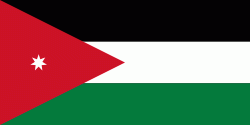Aqaba Governorate (Muḩāfaz̧at al ‘Aqabah)
Aqaba, the port at the Red Sea, plays an important role in the economic life of Jordan. Two of Jordan's top three tourist destinations lie in Aqaba Governorate, Wadi Rum, and the port city of Aqaba. The port is Jordan's most important import/export hub. The industrial port lies about 15 km to the south from the beaches and the Aqaba city center.
Aqaba Governorate lies in the south western tip of Jordan, it borders Ma'an Governorate from the east, Tafilah Governorate from the north, Saudi Arabia from the south, Israel from the west, and the Gulf of Aqaba from the southwest. There are two international crossing points in Aqaba Governorate, the Durra Border Crossing and Wadi Araba crossing.
The Jordanian-Saudi border originally ran a few kilometers south of Aqaba. In 1965 the late King Hussein exchanged 12 km of the valuable coastal strip for areas in the desert.
Map - Aqaba Governorate (Muḩāfaz̧at al ‘Aqabah)
Map
Country - Jordan
 |
 |
| Flag of Jordan | |
Modern-day Jordan has been inhabited by humans since the Paleolithic period. Three stable kingdoms emerged there at the end of the Bronze Age: Ammon, Moab and Edom. In the third century BC, the Arab Nabataeans established their Kingdom with Petra as the capital. Later rulers of the Transjordan region include the Assyrian, Babylonian, Roman, Byzantine, Rashidun, Umayyad, Abbasid, and the Ottoman empires. After the Great Arab Revolt against the Ottomans in 1916 during World War I, the Greater Syria region was partitioned by Britain and France. The Emirate of Transjordan was established in 1921 by the Hashemite, then Emir, Abdullah I, and the emirate became a British protectorate. In 1946, Jordan gained independence and became officially known in Arabic as the Hashemite Kingdom of Jordan. The country captured the West Bank during the 1948 Arab–Israeli War and annexed it until it was lost to Israel in 1967. Jordan renounced its claim to the territory in 1988, and became the second Arab state to sign a peace treaty with Israel in 1994.
Currency / Language
| ISO | Currency | Symbol | Significant figures |
|---|---|---|---|
| JOD | Jordanian dinar | دا | 3 |
| ISO | Language |
|---|---|
| AR | Arabic language |
| EN | English language |
















